Choosing a Gaming CPU: Single + Multi-GPU at 1440p, April 2013
by Ian Cutress on May 8, 2013 10:00 AM ESTCPU Benchmarks
Point Calculations - 3D Movement Algorithm Test
The algorithms in 3DPM employ both uniform random number generation or normal distribution random number generation, and vary in amounts of trigonometric operations, conditional statements, generation and rejection, fused operations, etc. The benchmark runs through six algorithms for a specified number of particles and steps, and calculates the speed of each algorithm, then sums them all for a final score. This is an example of a real world situation that a computational scientist may find themselves in, rather than a pure synthetic benchmark. The benchmark is also parallel between particles simulated, and we test the single threaded performance as well as the multi-threaded performance.
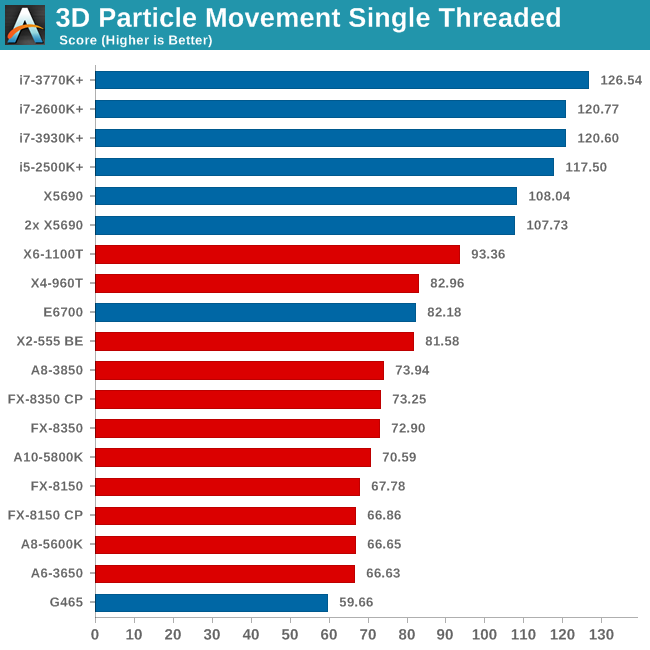
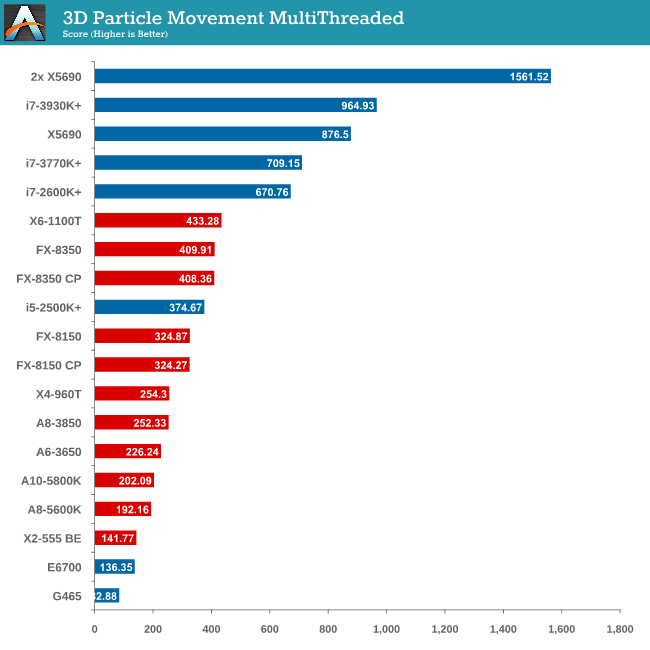
As mentioned in previous reviews, this benchmark is written how most people would tackle the situation – using floating point numbers. This is also where Intel excels, compared to AMD’s decision to move more towards INT ops (such as hashing), which is typically linked to optimized code or normal OS behavior.
Compression - WinRAR x64 3.93 + WinRAR 4.2
With 64-bit WinRAR, we compress the set of files used in our motherboard USB speed tests. WinRAR x64 3.93 attempts to use multithreading when possible and provides a good test for when a system has variable threaded load. WinRAR 4.2 does this a lot better! If a system has multiple speeds to invoke at different loading, the switching between those speeds will determine how well the system will do.
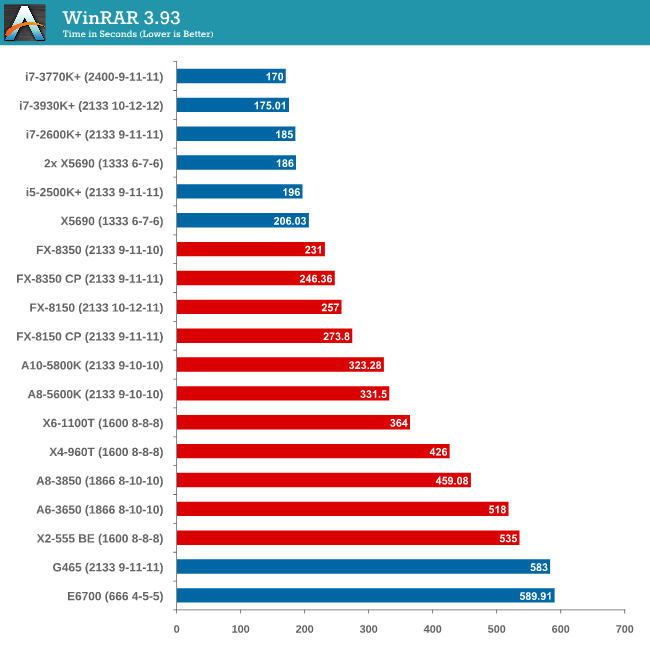

Due to the late inclusion of 4.2, our results list for it is a little smaller than I would have hoped. But it is interesting to note that with the Core Parking updates, an FX-8350 overtakes an i5-2500K with MCT.
Image Manipulation - FastStone Image Viewer 4.2
FastStone Image Viewer is a free piece of software I have been using for quite a few years now. It allows quick viewing of flat images, as well as resizing, changing color depth, adding simple text or simple filters. It also has a bulk image conversion tool, which we use here. The software currently operates only in single-thread mode, which should change in later versions of the software. For this test, we convert a series of 170 files, of various resolutions, dimensions and types (of a total size of 163MB), all to the .gif format of 640x480 dimensions.
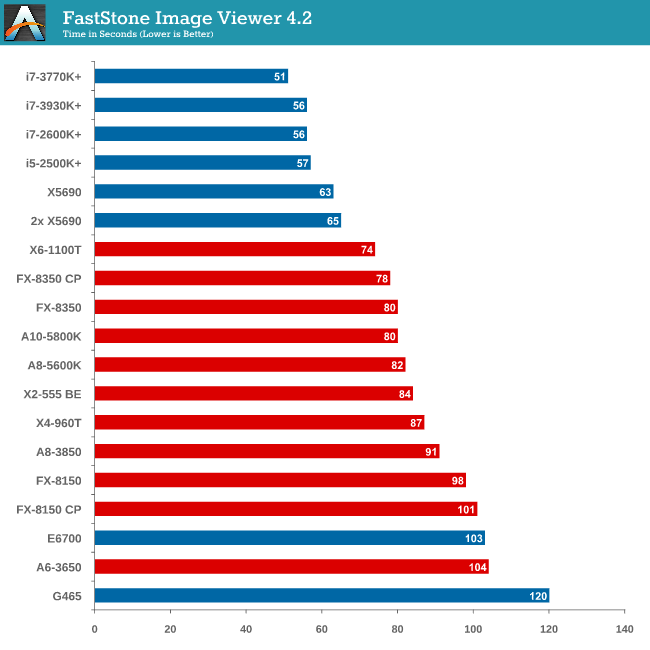
In terms of pure single thread speed, it is worth noting the X6-1100T is leading the AMD pack.
Video Conversion - Xilisoft Video Converter 7
With XVC, users can convert any type of normal video to any compatible format for smartphones, tablets and other devices. By default, it uses all available threads on the system, and in the presence of appropriate graphics cards, can utilize CUDA for NVIDIA GPUs as well as AMD WinAPP for AMD GPUs. For this test, we use a set of 33 HD videos, each lasting 30 seconds, and convert them from 1080p to an iPod H.264 video format using just the CPU. The time taken to convert these videos gives us our result.
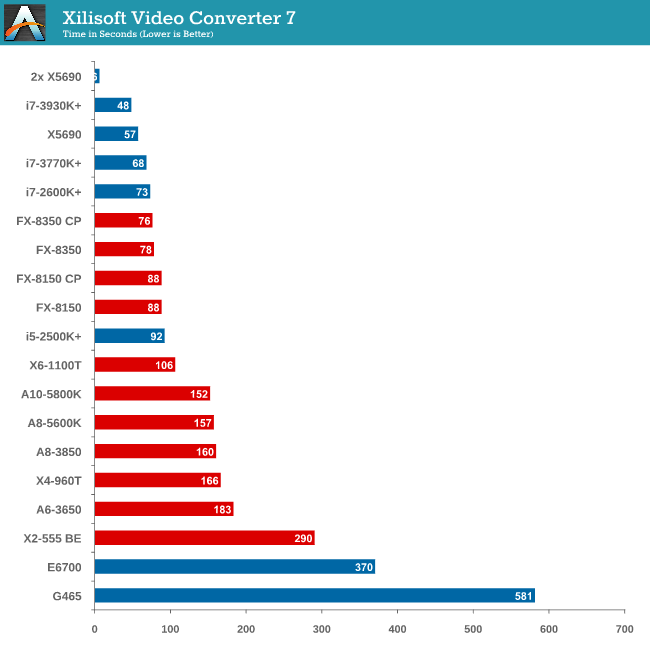
XVC is a little odd in how it arranges its multicore processing. For our set of 33 videos, it will arrange them in batches of threads – so if we take the 8 thread FX-8350, it will arrange the videos into 4 batches of 8, and then a fifth batch of one. That final batch will only have one thread assigned to it (!), and will not get a full 8 threads worth of power. This is also why the 2x X5690 finishes in 6 seconds but the normal X5690 takes longer – you would expect a halving of time moving to two CPUs but XVC arranges the batches such that there is always one at the end that only gets a single thread.
Rendering – PovRay 3.7
The Persistence of Vision RayTracer, or PovRay, is a freeware package for as the name suggests, ray tracing. It is a pure renderer, rather than modeling software, but the latest beta version contains a handy benchmark for stressing all processing threads on a platform. We have been using this test in motherboard reviews to test memory stability at various CPU speeds to good effect – if it passes the test, the IMC in the CPU is stable for a given CPU speed. As a CPU test, it runs for approximately 2-3 minutes on high end platforms.
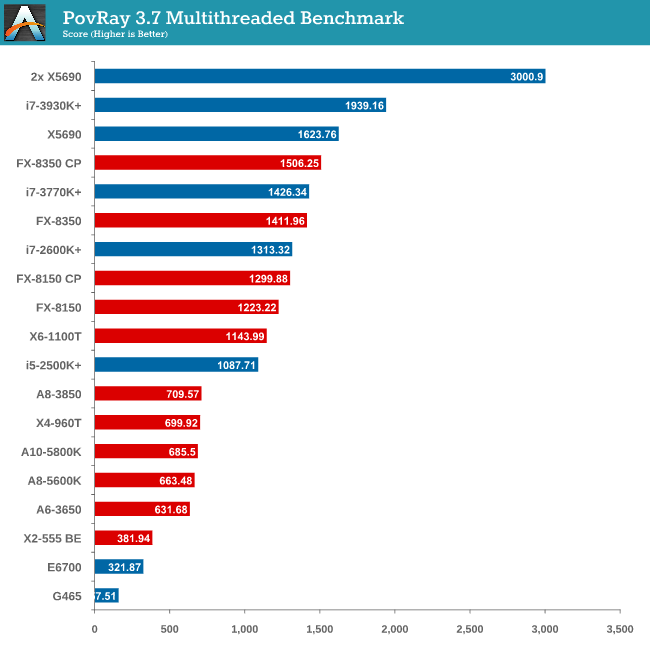
The SMP engine in PovRay is not perfect, though scaling up in CPUs gives almost a 2x effect. The results from this test are great – here we see an FX-8350 CPU below an i7-3770K (with MCT), until the Core Parking updates are applied, meaning the FX-8350 performs better!
Video Conversion - x264 HD Benchmark
The x264 HD Benchmark uses a common HD encoding tool to process an HD MPEG2 source at 1280x720 at 3963 Kbps. This test represents a standardized result which can be compared across other reviews, and is dependent on both CPU power and memory speed. The benchmark performs a 2-pass encode, and the results shown are the average of each pass performed four times.
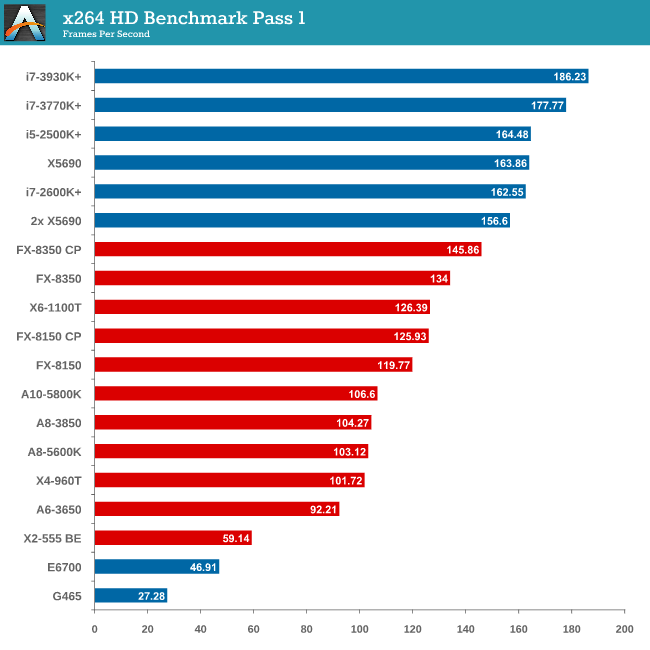
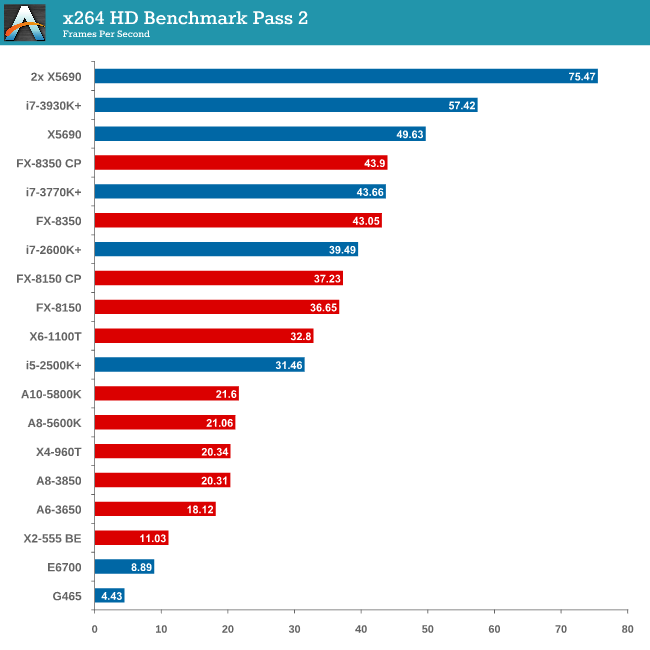
Grid Solvers - Explicit Finite Difference
For any grid of regular nodes, the simplest way to calculate the next time step is to use the values of those around it. This makes for easy mathematics and parallel simulation, as each node calculated is only dependent on the previous time step, not the nodes around it on the current calculated time step. By choosing a regular grid, we reduce the levels of memory access required for irregular grids. We test both 2D and 3D explicit finite difference simulations with 2n nodes in each dimension, using OpenMP as the threading operator in single precision. The grid is isotropic and the boundary conditions are sinks. Values are floating point, with memory cache sizes and speeds playing a part in the overall score.
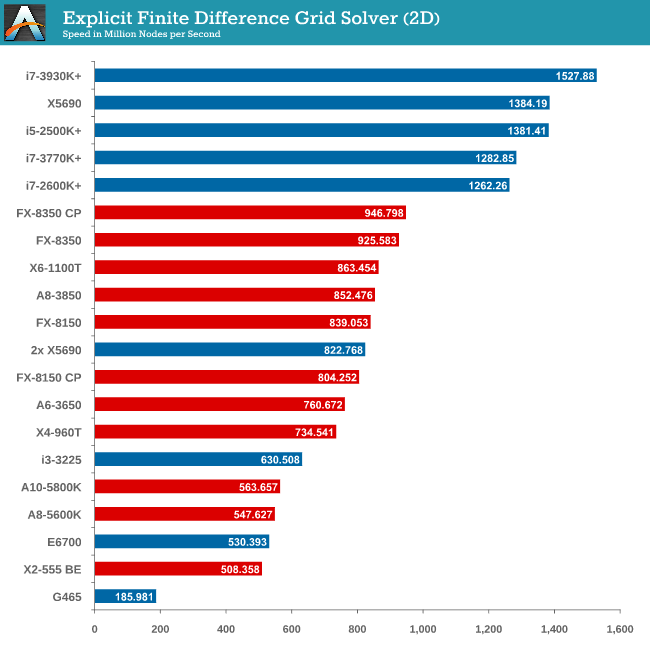
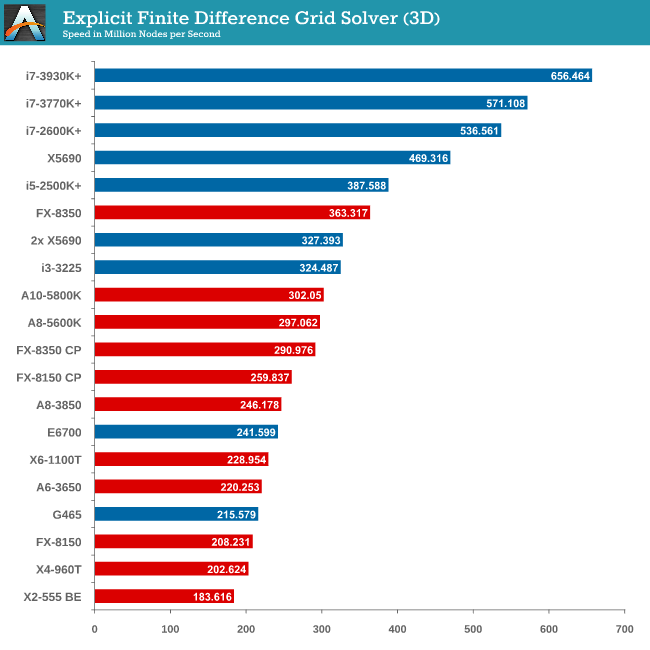
Grid solvers do love a fast processor and plenty of cache in order to store data. When moving up to 3D, it is harder to keep that data within the CPU and spending extra time coding in batches can help throughput. Our simulation takes a very naïve approach in code, using simple operations.
Grid Solvers - Implicit Finite Difference + Alternating Direction Implicit Method
The implicit method takes a different approach to the explicit method – instead of considering one unknown in the new time step to be calculated from known elements in the previous time step, we consider that an old point can influence several new points by way of simultaneous equations. This adds to the complexity of the simulation – the grid of nodes is solved as a series of rows and columns rather than points, reducing the parallel nature of the simulation by a dimension and drastically increasing the memory requirements of each thread. The upside, as noted above, is the less stringent stability rules related to time steps and grid spacing. For this we simulate a 2D grid of 2n nodes in each dimension, using OpenMP in single precision. Again our grid is isotropic with the boundaries acting as sinks. Values are floating point, with memory cache sizes and speeds playing a part in the overall score.
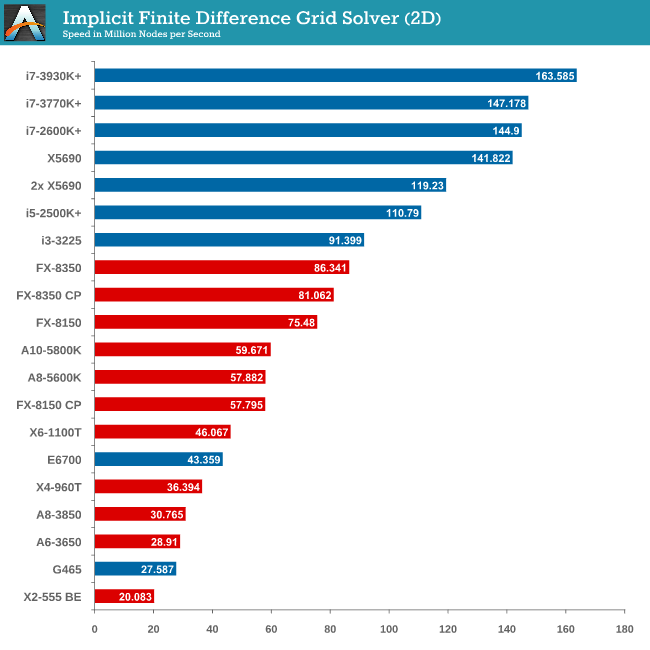
2D Implicit is harsher than an Explicit calculation – each thread needs more a lot memory, which only ever grows as the size of the simulation increases.
Point Calculations - n-Body Simulation
When a series of heavy mass elements are in space, they interact with each other through the force of gravity. Thus when a star cluster forms, the interaction of every large mass with every other large mass defines the speed at which these elements approach each other. When dealing with millions and billions of stars on such a large scale, the movement of each of these stars can be simulated through the physical theorems that describe the interactions. The benchmark detects whether the processor is SSE2 or SSE4 capable, and implements the relative code. We run a simulation of 10240 particles of equal mass - the output for this code is in terms of GFLOPs, and the result recorded was the peak GFLOPs value.
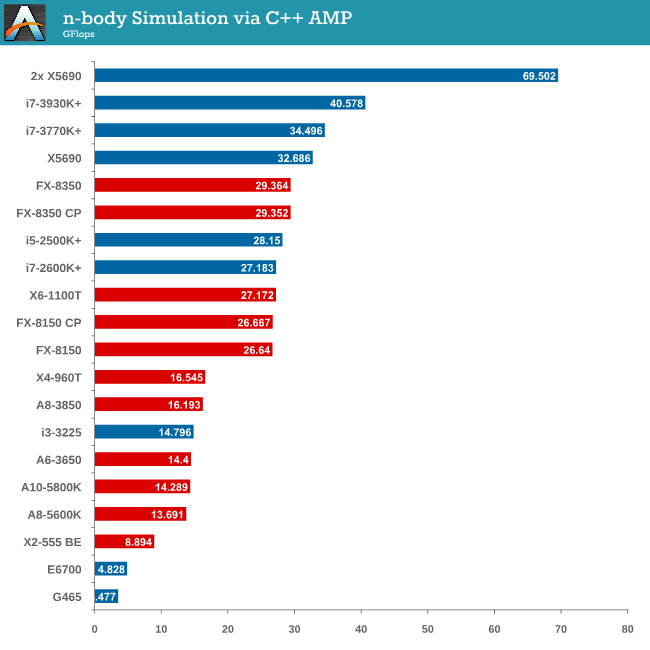
As we only look at base/SSE2/SSE4 depending on the processor (auto-detection), we don’t see full AVX numbers in terms of FLOPs.










242 Comments
View All Comments
Dribble - Wednesday, May 8, 2013 - link
Mmm, not done by a true gamer as it doesn't address a number of things:1) Not everyone wants to run the game at max settings getting 30fps. Many want 60, or in my case 120fps as that's what my monitor can do. To do this we turn down graphics a bit, but this makes us much more likely to be cpu bound. Remember generally you can turn down the graphics settings to ease strain on gpu for higher fps, but cpu settings are much more fixed - you can't lower the resolution or turn of AA to fix cpu bottlenecks!
2) Min fps is key, not average fps. This I learned years ago playing ut2004. That game might return 60fps most of the time while admiring the scenery, but when you were in the middle of an intense fight with multiple players fps could half or even quarter. It's obviously in the middle of a firefight that you most need the high fps to win.
3) There's a huge difference between single player games and online. Basically most single player games also run on consoles so they run like a dream on most PC cpu's as even the slower ones are more powerful. However go onto a 64 player server (which a console can't do) and watch the fps tank - suddenly the cpu is being worked much harder. BF3, UT engined games all do this when you get on a large server.
Hence your conclusions are wrong imo. You want an o/c intel quad core - i5 750 o/c to about 4ghz+ or better really. Why that - because basically it's still not far of as fast as you'll get - the latest intel cpu's still have 4 cores, ipc isn't much better and only clock a little higher then that.
maximumGPU - Wednesday, May 8, 2013 - link
i'm pretty sure there's a sizeable jump moving from an i5 750 to 3570K, in both ipc and potential for overclock.Dribble - Wednesday, May 8, 2013 - link
I suppose it depends on what you define "sizable" as? Perhaps a i2500K would be better, but even with a i5 750 @4ghz vs a i3570K@4.5ghz we aren't talking huge increases in cpu power - 25-30% maybe (hyperthreading aside which generally isn't much help in games).IanCutress - Wednesday, May 8, 2013 - link
I very much played a lot of clan-based BF2/BF2142 for a long while. 'True Gamer' is often a misnomer anyway, perpetuated by those who want to categorize others or want to announce their own true nature.1) The push will always be towards the highest settings at which you can hit that 60-120 FPS ideal. If some of the games we see today can't hit 60 on a single GPU at 1440p, at 4K it's all going to tank. Many games tested in this review hit 60+ above two GPUs which was the point of this article to begin with.
2) Min FPS falls under the issue of statistical reporting. If you run a game benchmark (Dirt3) and in one scene of genuine gameplay there is a 6-car pileup, it would show the min FPS of that one scene. So if that happened on an FX-8350 and min-FPS was down to 20 FPS when others didn't have this scene were around 90 FPS for minimum, how is that easily reported and conveyed in a reasonable way to the public? A certain amount of acknowledgement is made on the fact that we're taking overall average numbers, and that users would apply brain matter with regard to an 'average minimum'.
3) This is a bit obvious, but try doing 1400 tests on 64 player servers and keeping any level of consistency. If this is your usage scenario, then you'll know what concessions you will have to make.
An i5-750 using an older chipset also suffers from less of the newer features - native SATA 6Gbps for example for an awesome RAID-0 setup. This could be the limiting factor in your gaming PC. We will be testing that generation for the next update of this testing :)
As written in the review, the numbers we have taken are but a small subset of everything that is possible, and we can only draw conclusions from the numbers we have taken. There are other numbers available online which may be more relevant to you, but these are the ones under our test-bed situations. Your setup is different from someone elses, which is a different usage scenario from others - testing them all would require a few years in Narnia. But suggestions are more than welcome!
Ian
darckhart - Wednesday, May 8, 2013 - link
I agree with Dribble's post above, but your reply was also well thought and written, just like your article. Keep up the good work. Thanks!Dribble - Wednesday, May 8, 2013 - link
I suppose "true gamer" does sound a bit elitist, by that I really meant someone who plays not benchmarks. I agree it's hard to test min fps in 64 player BF3 matches, but that's the sort of moment when your choice of cpu matters, not in for example in a canned off-line BF3 benchmark. As you are advising on cpu buying choices for gaming it is pretty important.My personal experience is the offline canned benchmarks giving average fps say you require a cpu a lot less powerful then you really do when you take your fancy new rig online in the latest super popular multi player game. Particularly as in that game you pretty quickly start playing to win and are willing to sacrifice some fancy settings to get the fps up so you don't loose again as you try to hit that annoying fast moving 15 year old while your fps is tanking :)
Therefore while it's fine to advise those people who only want to play offline console ports using benchmarking as you did, it's just doesn't work for the rest of us.
JarredWalton - Wednesday, May 8, 2013 - link
It sounds more than a bit elitist: it is elitist. For every gamer that spends 10-20 hours of time each week in multiplayer gaming (MMORPG, or whatever FPS you want to name, or World of Tanks, etc.), there are likely at least ten times as many gamers that generally stick to single player games. What's more, that sort of definition of "true gamer" may as well just say "high school or early 20s with little life outside of the digital realm." Yes, that's a relatively big demographic, but there are many 20, 30, 40, and even 50-somethings that still play a fair amount of games, but never bother with the multiplayer stuff. In fact, I'd say that of the 30+ year old people I know well, less than 1% would meet your "true gamer" requirement, while 5% would still be "gamers".Says the 39 year old fuddy duddy.
Spunjji - Wednesday, May 8, 2013 - link
The purpose of this article is to give a scientific basis for comparison within the boundaries of realistic testing deadlines. I would be interested to see you produce something as statistically rigorous based on performance numbers taken from online gaming. If you managed to do it before said numbers became irrelevant due to changes to the game code I would be utterly flabbergasted.Dribble - Thursday, May 9, 2013 - link
No, the purpose of this article is to recommend cpu's for gaming.frozen ox - Thursday, May 9, 2013 - link
There is no way to recreate or capture all the variables/scenarios to repeatedly benchmark a firefight in BF3 across multiple systems. The results from this hardware review are relevant, because they are easily repeatable by others and provide a fair baseline to compare systems. The point of this study is not what CPU do I need to play BF3 or Crysis at max settings, it's how much bandwidth bottleneck is going on with a single GPU setup? What happens in reality with multi-GPU setups? How well does the new AMD architecture (because "true gamers" want to save $$ to buy games) compare to Intel?What you have to do, as a "true gamer" and someone who has enough wits about them, is extrapolate the results to your scenario because everyone's will be different. And honestly, anyone who plays FPS...the "true gamers", will know what you pointed out. It's insanely obvious even the first time you play a demanding FPS MMPOG like BF3.
I however, play single player 99% of the time. Only online FPS I'll play now is CS.